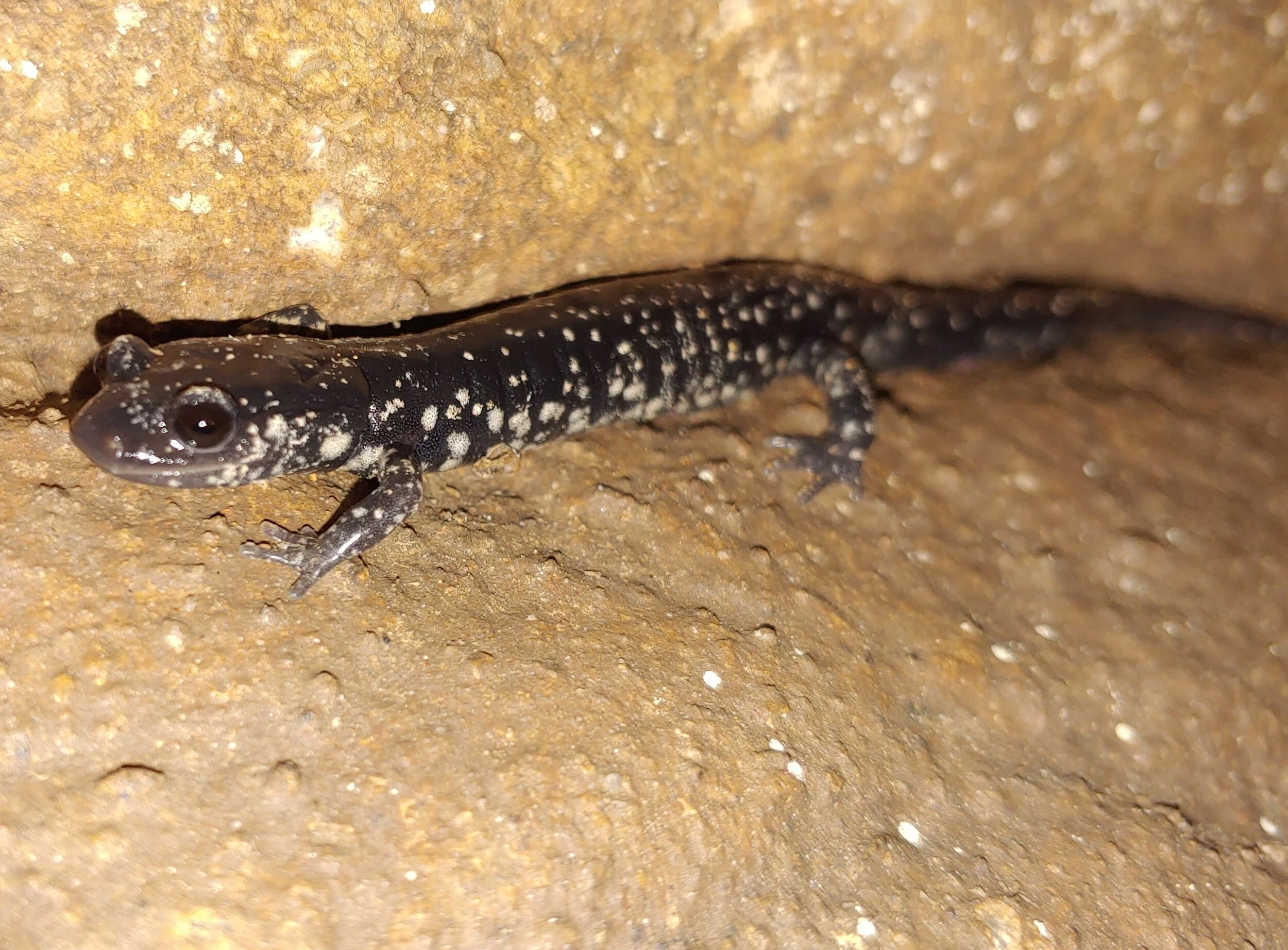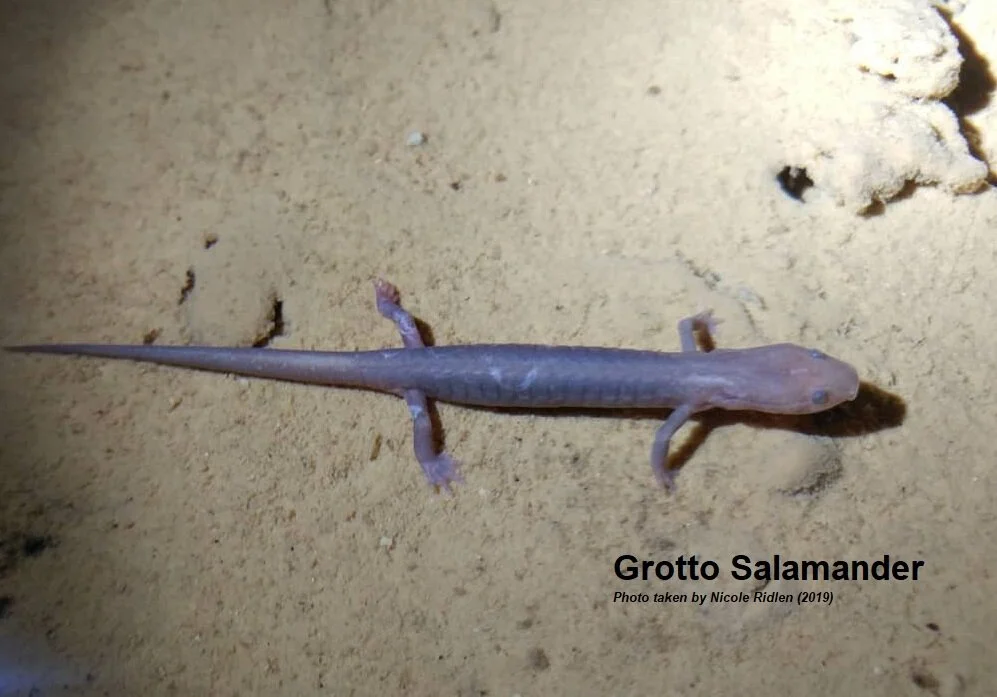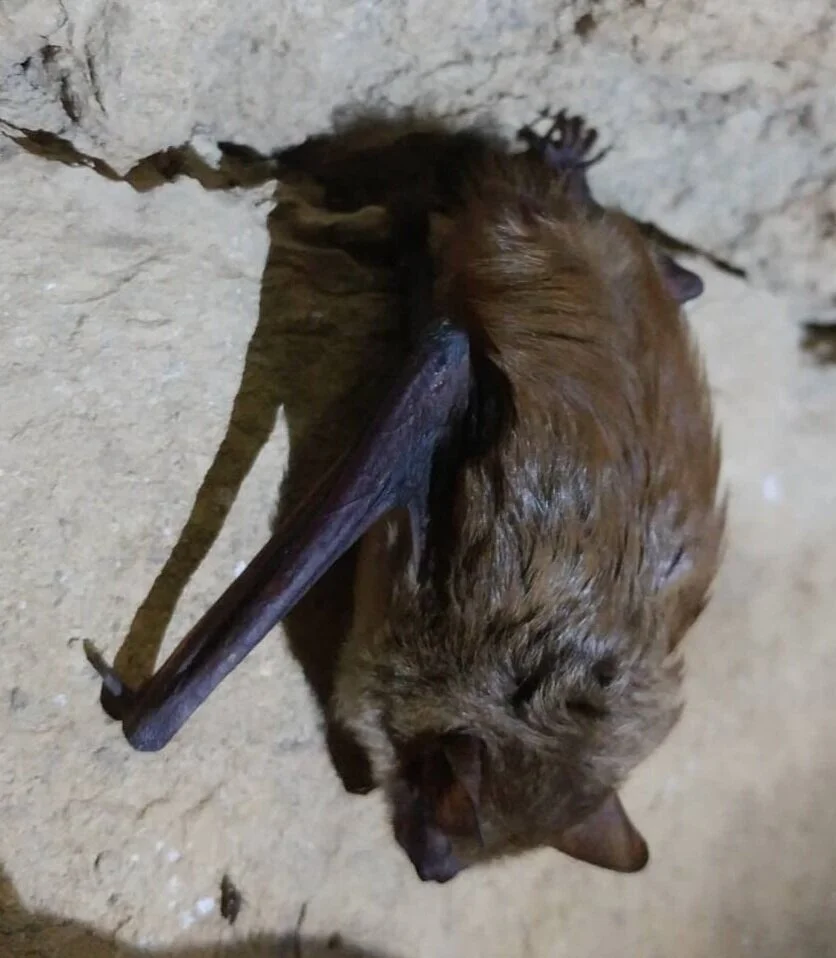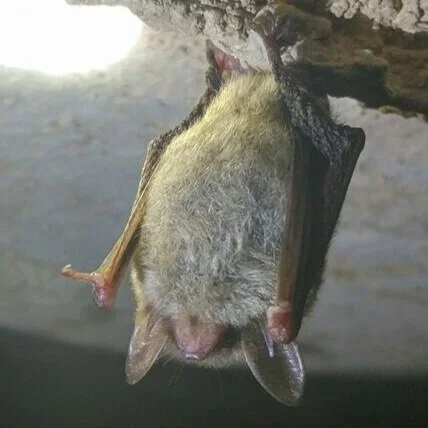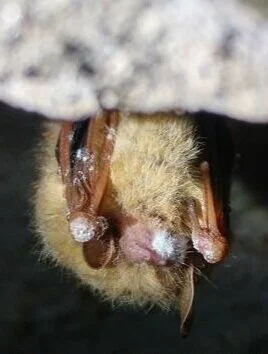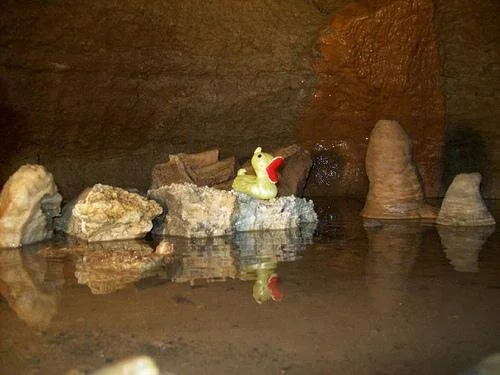Animals
Cave Salamander
(Eurycea lucifuga)
This species of salamander is the most abundant in our cave and can be seen almost every day! Cave Salamanders typically dwell in the twilight zones of caves (dimly lit area beyond the cave entrance) where their food (insects) is sure to be adundant. Despite their name, Cave Salamanders have been found to live in areas outside of caves under logs, in small streams and other wet areas.
Typically bright orange in color,but varying from yellow-brown to orange-red, this medium-sized salamander can be distinguished by the black spots and spotless yellow orange belly with a long tail. They can get relatively large for a salamander, with adults up to 8″ in length! This species of salamander is a lungless salamander. The young are born with gills and need to remain in the water to survive. As they morph into their adult forms they lose their gills and breathe through their skin since they lack lungs.
Western Slimy Salamander
(Plethodon albagula)
These salamanders are typically found under rocks and in moist, wooded areas as well as the entrances of caves. The Western Slimy Salamander is black in color with white or silver speckling, large bulbous eyes, and a long tail. They range from 4 inches to more than 6 inches in length and weigh less than one ounce. These salamanders are another species that are lungless. Unlike the Cave Salamander, Western Slimy Salamanders are born just like adults. The female salamander will lay eggs and remain with them until they hatch. The young have no aquatic larvae stage and are born without lungs, breathing through their skin.
Grotto Salamander
(Eurycea spelaea)
These salamanders are true cave salamanders and are one of the true troglobites. Troglobites are animals that live in complete darkness. Grotto salamanders are albino, being pink to beige in color, and as adults they lose their eyesight. Their lack of eyesight makes them extremely vulnerable to predation and they rely on complete darkness for protection. The larvae of grotto salamanders are born with sight and have gills and may live outside of a cave in streams or brooks. Once they mature into adulthood they retreat back into the caves where they live quiet lives.
Dark-Sided Salamander
(Eurycea longicauda melanopleura)
Dark-sided salamanders are a subspecies of Long-tailed salamanders, native to SW Missouri. They live in caves and other wet areas. They eat small insects and invertebrates and like many other salamanders they lack lungs and breathe through their skin. The eggs of dark-sided salamanders are laid in water and when they hatch the young are aquatic, using gills to breathe. They mature into their adult forms at about 7 months of age, when they lose their gills and begin breathing through their skin.
Oklahoma Salamander
(Eurycea tynerensis)
Oklahoma salamanders are near-threatened and should be protected from harm. This species is born with gills and can remain in this aquatic state permanently. They have only been seen in recent times to mature to their adult stage (a loss of gills) in labs with a treatment of thyroxin. The Oklahoma Salamander remaining in an aquatic state with lungs leaves the species particularly vulnerable to water level & quality changes. This species was not known to live deep in caves until habit loss began to present an issue and the Oklahoma Salamander populations began retreating deeper into caves.
Pickerel Frog
(Lithobates palustris)
Pickerel frogs are 1.75″-3″ in length and have square-rectangular spots in two parallel rows down the back. The belly is white. These frogs are commonly associated with cool cave springs and can be found in caves all over the southern half of the state. They do NOT live their entire life-cycle in the cave and can come and go as they please. They are important as they can keep troublesome insects down in population AND when they die in the cave they are a popular food source for Bristly Cave Crayfish. Not to be confused for the leopard frogs, which lack the distinct two-rows of square/rectangular spots down the back.
Tri-Colored Bat
(Perimiotis subflavus)
The tri-colored bat (formerly known as the eastern pipistrelle) is one of the most common species of bats found in our cave. The fur of the Tri-Colored bat is banded with three colors, black at the base, yellow in the middle, and brown at the tips. This causes them to vary in color depending on how their fur lays. They are the loners of the Bluff Dwellers Cave bats, often found hanging out upside-down individually throughout the cave. These bats are among the first bats to emerge at dusk each night.
These bats have been found to feed on large hatches of grain moths emerging from corn cribs, indicating that they may be of important agricultural benefit. Tri-colored bat cannot withstand freezing temperatures and are among the first bats to enter hibernation each fall and among the last to emerge in spring. In the early Fall they begin to mate, and the female bat will hold onto the sperm until Spring when she will impregnate herself if the time is right. Hibernation sites are found deep within caves or mines in areas of relatively warm (close to 50 F), stable temperatures. The top left photo is a Tri-Colored Bat in Bluff Dwellers Cave.
Big Brown Bat
(Eptesicus fuscus)
The big brown bat is a seasonal resident of Bluff Dwellers Cave, only using the cave during the winter hibernation period. As the species name suggests, the big brown bat has brown, moderately-long fur that is shiny with dark brown to black skin on the wings, ears, face and feet. These bats are insectivores, consuming large quantities of insects every night. It is one of the larger species of bats found here in Missouri.
During the winter these bats cluster together in groups of up to 100. Strangely these bats give birth to a different number of pups depending on their geographic location. Here in Missouri and East of the Rocky Mountains the Big Brown Bat females usually give birth to twins. Everywhere West of the Rocky Mountains the Big Brown Bats only give birth to single pups. The second and third bat photo to the left are Big Brown Bats.
Northern Long-Eared Bat
(Myotis septentrionalis)
The Northern Long-eared bat is only occasionally a visitor here at Bluff Dwellers Cave. The fur of the Northern Long-eared is light brown with wings that are also light brown, with long ears that have a long, straight, pointed tragus (the piece that sticks out inside the ear). This species of bats is mostly seen solitary. They spend the warm months outside, roosting in trees, old barns, attics and other abandoned structures. They eat many flying insects every night. When the weather becomes too cold and their food source disappears they migrate into caves to survive the winter hibernating.
They are insectivores, eating their weight in mosquitos, moths, wasps, gnats and mayflies every night. The bat’s diet makes it beneficial to agriculture as it eats many insects that are a problem pest for farmers. This species mates in late Summer/ early Fall and the female will impregnate herself with the stored sperm. Gestation lasts 50-60 days at which time the female bat, living in a maternity colony during the spring, gives birth to a single bat. These bats are in danger from WNS and in some locations where they used to be abundant 99% or more have died from a result of the disease.
Bats & White-nose Syndrome (WNS)
White-nose Syndrome (WNS) is a fungal infection in bats that has begun emerging in North America. First identified in a bat in a cave in New York in 2006, by 2012 WNS was responsible for more than 7 million bat deaths. The disease is caused by the fungus Pseudogymnoascus destructans and has no known cure or treatment. Caves that are infected often report a mortality rate of 90% or more bats. The U.S. Fish & Wildlife Service strongly recommends decontamination of all caving clothing and gear between caves to prevent the spread of WNS. The disease is found in bats in Europe where bats seem to have developed an immunity to the fungus. It is thought that in 2006 it was spread from Europe to North America by human activity, and the bats here have not yet developed any immuno response.
Bluff Dwellers Cave is inspected annually by the Missouri Bat Census. McDonald County was first verified to have WNS in the winter of 2014-15 and our bats began to show signs of WNS in the Winter of 2017-18. Since then we have seen a large drop in bat population that uses our cave as a hibernaculum. For more information on WNS visit https://www.whitenosesyndrome.org.
Bristly Cave Crayfish
One of Bluff Dwellers Cave’s troglobites, the Bristly Cave Crayfish is a shy animal. It is white in color with small, unpigmented eyes , long slender pinchers and long setae (bristles). The long bristles on this species of crayfish assist it with being able to get around in total darkness. It is mostly a scavenger, eating decaying plant or animal matter that filters into the cave, but does eat small insects and isopods. Not much is known about the Bristly Cave Crayfish due to it’s difficult-to-explore habitat in small water-filled passageways and underground streams. At Bluff Dwellers seeing a Bristly Cave Crayfish is a rare treat as some can be in the cave every day for a year and be lucky to see one of these elusive creatues just once!
The Cave Duck
The Antique Cave duck has been in our cave long enough that he is a naturalized citizen of the cave! For over 75 years the duck has been perched near a naturally-formed “duck pond”, and has been photographed by countless guests. Come see the beautiful cave and The Antique Cave Duck.

